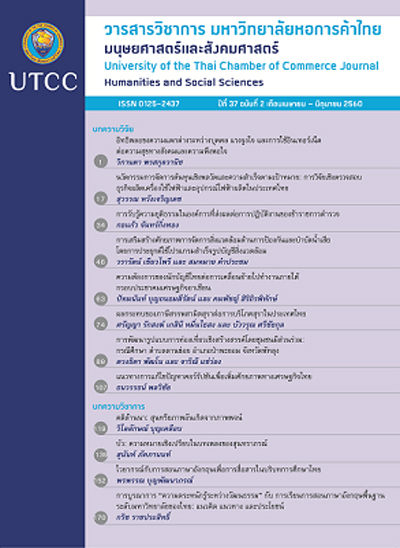Legal Issues about the Control the Movement, Case of Root Balled Plants for Landscape
Main Article Content
Abstract
The Forest areas are significantly reduced, as reported by the Forest Department in 2017.
An awareness of planting trees should be taking into consideration in order to increase the forest
area. There are currently only measures to prevent illegal logging, but for landscaping there is no
measure Landscaping is concerning moving trees from one place to another for beauty by using
small, medium and large trees. Generally, such trees are bought from a tree seller who sell digging
trees. However, there is always no evidence to prove that the trees used in such works come
from a tree seller who plant tress for selling. It is possible that such trees come farming source,
including national park. At the same time, some of the trees were originally banned. However,
nowadays people are allowed to grow their own crops. As a result, it is more difficult to monitor
the source of the tree. More importantly, the tree transporting in landscaping always comes with
living tree with leaves, stems and roots. Moving such trees to other places accordingly has not
been strictly monitored by government officials. It must be clearly and concisely verified by the
government. It is noted in the legal issue that the law which governs the movement of trees for
landscaping should be considered. In other countries such as Singapore, where the strict control
of tree movement is enforced. Unlike Thailand, where there is no control. So the reduced forest
area is caused by deforestation by digging trees out of the forest for use in landscaping.
Article Details
ลิขสิทธิ์ของบทความ
ผลงานที่ได้รับการตีพิมพ์ถือเป็นลิขสิทธิ์ของมหาวิทยาลัยหอการค้าไทย ห้ามมิให้นำเนื้อหา ทัศนะ หรือข้อคิดเห็นใด ๆ ของผลงานไปทำซ้ำ ดัดแปลง หรือเผยแพร่ ไม่ว่าทั้งหมดหรือบางส่วนโดยไม่ได้รับอนุญาตเป็นลายลักษณ์อักษรจากมหาวิทยาลัยหอการค้าไทยก่อน
References
Constitution of the Kingdom of Thailand 2560 B.E. (A.D. 2017). (in Thai).
Customs Act B.E. 2469 (A.C.1926). (in Thai).
Department of Agriculture. (2004). Ratchaphruek academic documents: Ornamental plants. Bangkok,Thailand: Author. (in Thai).
Department of International Trade Promotion. (2012). UAE Open Market for Ornamental Plants. Retrieved September 5, 2017, from https://www.ditp.go.th/contents_attach/66871/55000682.doc
Forest Park Act B.E. 2535 (A.C. 1992). (in Thai).
Forestry Act B.E. 2484 (A.D. 1941). (in Thai).
Ministry of Natural Resources and Environment. (2015). Strategic Plan, Ministry of Natural Resources and Environment B.C. 2016 – 2021. Bangkok,Thailand: Author. (in Thai).
Narat, S. (2006). Excavated at Kaeng Khoi Daily turnover of Baht million. The Ornamental Plants
Magazine, 5(53), 11-12. (in Thai).
National Forest Act B.E. 2507 (A.D. 1964). (in Thai).
National Parks Act A.D.1990, Parliamentary Republic. Republic of Singapore.
Parks And Trees Act A.D. 2006. Parliamentary Republic. Republic of Singapore
Prombutr, K. (2004). Financial and marketing analysis of balled plants produced in Nonthaburi Province (Unpublished master’s thesis). Kasetsat University, Bankok,Thailand. (in Thai).
Saisoonthorn, S. (2013). Semi-Automatic Tree. Retrieved September 5, 2017, from
https://www.ku.ac.th/web2012/index.php?c=adms&m=seltab_th&time=20131114135635&page=&page1=&load=tab&lang=thai&ip=10&id=892&id1=128 , 14 November 2013. Bankok,Thailand. (in Thai)
Thai Customs. (2015). Report on export of ornamental plants in Thailand exported ornamental plants. Bangkok, Thailand. (in Thai).


